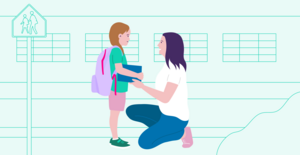Key points
- Diabetic ketoacidosis (DKA) is a serious complication of diabetes caused by the body breaking down fat for energy instead of glucose.
- DKA symptoms include high blood sugar levels, excessive thirst, frequent urination, nausea, and fatigue. If untreated, it can lead to coma or death.
- DKA is usually triggered by factors such as illness, infection, missed insulin doses, or inadequate insulin therapy.
- Treatment for DKA typically involves intravenous fluids, insulin therapy, and electrolyte replacement.
- People with a higher risk of hyperglycemic blood sugar levels, such as those with insulin deficiency, newly diagnosed diabetes, or those who are pregnant, may benefit from at-home ketone tests.

Diabetic ketoacidosis (also known as “DKA”) is a serious and potentially life-threatening complication of diabetes, according to the American Diabetes Association (ADA). It occurs when the body starts breaking down fat for energy instead of glucose, leading to a buildup of ketone levels in the blood. DKA is most commonly seen in people with type 1 diabetes, but it can also occur in people with type 2 diabetes, according to the CDC.
Common symptoms of DKA include high blood sugar levels (also known as hyperglycemic blood sugar levels), excessive thirst, frequent urination, nausea and vomiting, abdominal pain, weakness and fatigue, shortness of breath, and confusion. If left untreated, DKA can lead to coma and even death, according to the ADA. Therefore, it is important to recognize the symptoms and seek medical attention immediately if you suspect you or someone you know may have DKA.
The causes of DKA vary, but the ADA notes that it is usually triggered by a combination of factors such as illness, infection, missed insulin doses, or inadequate insulin therapy. Treatment for DKA typically involves intravenous fluids to rehydrate the body, insulin therapy to lower blood sugar levels, and electrolyte replacement to correct imbalances. With prompt and appropriate treatment, most people with DKA can recover fully within a few days, according to the ADA.
Causes of DKA
Diabetic ketoacidosis (DKA) occurs when your body produces high levels of blood acids called ketones, according to the ADA. This happens when your body does not have enough insulin to convert glucose into energy, so it starts to break down fat instead. The following are some of the most common causes of DKA, according to the CDC:
Illness
If you’re not able to eat and drink as normal, it can be difficult to manage your blood sugar levels, according to the ADA. Additionally, your body may make more stress hormones, which can cause your blood sugar levels to rise, leading to DKA.
A problem with insulin therapy
If you have diabetes and use insulin, it is important to monitor your blood sugar levels regularly, according to the ADA. They note that if you do not take enough insulin, or if you take too much, it can lead to DKA.
Physical or emotional trauma
Physical or emotional stress can cause your body to produce stress hormones, which can lead to DKA, according to the ADA. This can happen if you have been in an accident, have undergone surgery, had a medical emergency (like a heart attack or stroke), or are experiencing a stressful event they note.
Pregnancy
Pregnancy can cause changes in your hormone levels, which can affect your body's ability to produce insulin, according to the ADA. This can also lead to DKA if you have unmanaged or mismanaged diabetes.
Alcohol or drug misuse
Alcohol and drug misuse can affect your body's ability to produce insulin and regulate blood sugar levels, according to the ADA. This can also lead you to not manage your diabetes well if you have it — both of these situations may lead to DKA.
Certain medicines, such as corticosteroids and some diuretics
Some medications, such as corticosteroids and diuretics, can affect your body's ability to produce insulin, according to the ADA.
Signs and Symptoms for Diabetic Ketoacidosis
If you have diabetes, it's important to be aware of the signs and symptoms of diabetic ketoacidosis (DKA). DKA is a serious complication of diabetes that can be life-threatening if left untreated, according to the ADA.
Some common signs and symptoms of DKA, according to the CDC, are:
High Blood Sugar Levels
One of the most common signs of DKA is high blood sugar levels. If your blood sugar levels are consistently above 250 mg/dL, you may be at risk for developing DKA, according to the CDC. It's important to monitor your blood sugar levels regularly if you have diabetes and to seek medical attention if they remain high despite treatment.
Excessive Thirst and Urination
Another common symptom of DKA is excessive thirst and urination. This is because high blood sugar levels can cause your body to lose fluids more quickly than usual, according to the ADA. If you find yourself drinking more fluids than usual and urinating more frequently, it's important to talk to your doctor.
Nausea and Vomiting
Nausea and vomiting are also common symptoms of DKA. These symptoms can be caused by the buildup of ketone levels in your blood, which can cause your stomach to become upset, according to the CDC.
Abdominal Pain
Abdominal pain is another symptom of DKA that you may experience. This pain can be caused by the buildup of ketone levels in your blood, which can irritate your stomach and cause discomfort, according to the CDC.
Difficulty Breathing
In severe cases of DKA, you may experience difficulty breathing, according to the CDC. This is because high levels of ketone levels in your blood can cause your body to become acidic (known as acidosis), which can affect your breathing.
Having Fruity-Scented Breath
Fruity-scented breath is also a sign of DKA, according to the NIH. This is because one of the three primary ketone bodies that are made during DKA is acetone, which can smell fruity when released through exhalation.
Being Confused
Diabetic ketoacidosis can make you feel confused and irritable, according to the CDC. Sometimes this can manifest as acting drunk or speaking incoherently, they note.
How Do You Prevent DKA?
Preventing diabetic ketoacidosis (DKA) is important for people living with diabetes, according to the ADA. They also list some tips that can help you avoid it:
- Monitor your blood sugar levels regularly: Check your blood sugar levels as often as your healthcare provider recommends. This will help you stay on top of your diabetes management and detect any changes in your blood sugar levels early on. You should also consider wearing a monitor that constantly monitors your blood sugar and alerts you when you are out of range.
- Take your insulin as prescribed: If you take insulin, make sure you take it as prescribed by your healthcare provider. Skipping doses or taking too little insulin can cause your blood sugar levels to rise and lead to DKA.
- Follow a healthy diet: Eating a healthy, balanced diet can help you manage your blood sugar levels and prevent DKA. Avoid foods that are high in sugar and carbohydrates, and focus on eating lean protein, whole grains, and plenty of fruits and vegetables.
- Stay hydrated: Drinking plenty of water can help prevent dehydration, which can contribute to DKA. Aim to drink at least eight glasses of water a day, and more if you are exercising or spending time outdoors in hot weather.
- Be aware of the signs of DKA: Knowing the signs of DKA can help you catch it early and prevent it from becoming a serious complication. Symptoms of DKA include high blood sugar levels, ketones in your urine or blood, nausea and vomiting, abdominal pain, and fruity-smelling breath.
- For those who are at higher risk of hyperglycemic blood sugar levels, using ketone tests can help you monitor if you are in ketosis at home. Ketone tests are sold over the counter and often used by people who have hyperglycemic blood sugar levels, and also people who follow keto diets as a way of losing weight.
Treatment for Diabetic Ketoacidosis
If you are diagnosed with diabetic ketoacidosis (DKA), you may need to be hospitalized to receive treatment and be monitored for complications, according to the NIH. The goal of treatment is to correct the high blood sugar levels and acidosis, as well as to prevent complications.
The treatment for DKA typically involves a combination of insulin therapy, fluid replacement, and electrolyte replacement, according to the ADA. They note that insulin is given to lower blood sugar levels and to stop the production of ketones, white fluids are given to replace the fluids lost due to excessive urination and vomiting. Electrolytes, such as potassium and sodium, are also given to replace to help maintain normal bodily functions.
During treatment, your blood sugar levels will be monitored closely, according to the NIH. In some cases, you may need to receive insulin through an IV to bring your blood sugar levels down quickly. As your blood sugar levels begin to normalize, your insulin therapy will be adjusted accordingly.
In addition to medical treatment, it is important to address the underlying cause of DKA. This may involve adjusting your diabetes management plan, such as changing your insulin dosage or adjusting your diet. It is also important to monitor your blood sugar levels more closely and to seek medical attention if you experience any symptoms of DKA.
DKA Risk Factors
Diabetic ketoacidosis (DKA) is a serious complication of diabetes, which can be life-threatening if not treated promptly, according to the ADA. Although anyone with diabetes can develop DKA, certain factors increase the risk of developing this condition.
Factors that increase the risk of DKA:
- Insulin deficiency: DKA occurs when there is a lack of insulin in the body, according to the ADA. They note that this can happen when you don't take enough insulin, miss insulin doses, or have an illness or infection that increases your need for insulin.
- High blood sugar levels: DKA is more likely to occur when your blood sugar levels are consistently high, according to the ADA. This can happen if you don't monitor your blood sugar levels regularly, or if you have an illness or infection that increases your blood sugar levels.
- Infection or illness: Having an infection or illness can increase your risk of developing DKA. This is because infections and illnesses can cause your body to produce stress hormones, which can raise your blood sugar levels and make it harder for your body to use insulin, according to the ADA.
- Newly diagnosed diabetes: If you have recently been diagnosed with diabetes, you may be at a higher risk of developing DKA, according to the ADA. This is because your body may not be used to the changes in insulin levels and blood sugar control.
- Pregnancy: Pregnant women with diabetes are at a higher risk of developing DKA, especially if they have poorly controlled blood sugar levels, according to the ADA.
- Alcohol and drug use: Alcohol and drug use can increase the risk of DKA by causing dehydration, which can lead to high blood sugar levels, according to the ADA.
Urgent Care Near Me
If you are experiencing symptoms of diabetic ketoacidosis (DKA), it is important to seek immediate medical attention right away. If your primary doctor is unavailable, going to an urgent care clinic is a great option. You can find the highest-rated urgent care clinics near you and save your spot in line using Solv.
FAQs
What is Diabetic Ketoacidosis (DKA)?
DKA is a serious complication of diabetes where the body breaks down fat for energy instead of glucose, leading to a buildup of ketones in the blood.
What are the symptoms of DKA?
Symptoms include high blood sugar levels, excessive thirst, frequent urination, nausea, vomiting, abdominal pain, weakness, fatigue, shortness of breath, and confusion.
How is DKA treated?
Treatment typically involves intravenous fluids to rehydrate the body, insulin therapy to lower blood sugar levels, and electrolyte replacement to correct imbalances.
What triggers DKA?
DKA can be triggered by a combination of factors such as illness, infection, missed insulin doses, or inadequate insulin therapy.
Can DKA be fatal if left untreated?
Yes, if left untreated, DKA can lead to coma and even death.









